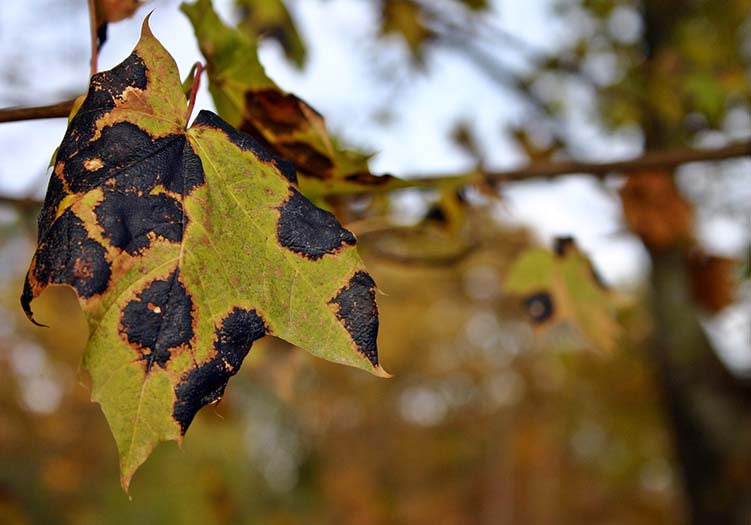Your shopping cart is currently empty.
| Subtotal | €0,00 |
| Shipping Rate | including VAT, excl. Shipping Rate |
| Total | €0,00 |
|---|
31.07.2023
Tree diseases and pests ensure that our trees of all ages are no longer doing well in the long term. Like us humans, they can suffer from various diseases. Some of them even pose a serious threat to the trees and cause them to die.
It is especially bad when such Diseases and Pest infestations spread in whole forests. This can kill many trees and through Tree dying the lives of us humans are also affected. Trees give us the precious and vital oxygen and filter the air with which we fill our lungs. They also provide us with delicious and healthy fruit. We must not even think up what it means if one day this is no longer possible.
Here you will find an overview of which trees suffer from which tree diseases and pests.
Why are there more tree diseases and pests in today's age?
The Climate change unfortunately up to mischief in every respect. Our trees in particular suffer greatly from this. In addition to the lack of water supply, tree diseases and pests are a consequence of climate change.
We have been struggling with global warming for a number of years. This means that our average temperature rises sustainably and the climate zones change. Lack of rain is a big side effect of this, as well as long Hot spells. When our trees can no longer drink, they suffer from severe thirst that too Drought stress and ultimately make them sick. It is the same as it is with us humans.
The mild temperatures also ensure that pests essential multiply faster and can spread. They can hatch earlier, grow faster and thus infest our trees unrestrainedly.
Here you can find more information on the causes and consequences of climate change. (Link article)
What damage can our trees suffer from?
When it comes to tree diseases, we differentiate between parasitic and non-parasitic damage. Parasitic damage is caused by various insects or microorganisms. Non-parasitic damage can result from various environmental influences.
Parasitic causes of damage
- mushrooms
- Viruses
- bacteria
- insects and larvae
- small mammals
Non-parasitic causes of damage
- drought
- frost
- Very wet
- nutritional deficiency
- Exhaust gases, road salt, acid rain
The tree diseases and pests of our different tree species
Many trees have different natural pests and also suffer from different diseases. Here you will find an overview of the problems our trees are struggling with.
The spruce and the bark beetle
The spruce covers about 28% of the German forest area and is therefore the most common tree species. The greatest enemy of the spruce is that Bark beetlewhich can cause considerable damage to entire forests. A healthy tree does very well against a small one Bark beetle infestation to fight back. It produces more tree sap, which prevents the bark beetles from penetrating the tree bark.
Unfortunately, this natural protective mechanism does not work in the case of weakened trees and excessive pests. The bark beetles are so dangerous that they lay their eggs under the bark. The most important layers of the tree trunks are eaten by the hatching larvae under the bark. This means that the tree's lifelines are severely damaged and the “water line” into the tree top is interrupted, which ultimately causes the spruce to die.
The endangered chestnut
The buckeye is particularly threatened by bacterial death. The bacterial horse chestnut dying affects trees of all ages. The rapidly spreading disease is triggered by the bacterium Pseudomonas syringae pv. Aesculi.
The infestation ensures black discharge on the trunk and branches. The tree suffers, bleeds and later forms black crusts. Ultimately, the bacterium leads to wood-destroying colonization by fungi. Cracks in the trunk and branches are the result, the trunk can no longer supply the crown with nutrients and parts of the crown die off.
Also from the Chestnut leaf miner (Cameraria ohridella) the horse chestnut is attacked. Mainly the leaves are affected, they turn brown and fall off prematurely.
What can you do now Improve the location of the tree, disinfect cutting tools, remove leaves in autumn, properly dispose of infected material and cut the tree if there is a risk to traffic safety.
The death of the ash shoots
The type of fungus Chalara fraxinea has a massive impact on the development and distribution of the ash and causes ash dieback. You can tell that the tree is no longer feeling good by dying branches, discoloration of the bark of infected shoots, increased new shoots and wilting leaves. Premature leaf fall is life-threatening for every tree.
You can watch the process and remove deadwood. Precipitation is only necessary if the infestation is very severe.
The oak and its oak processionary moth
The oak processionary moth (Thaumetopoea processionea) is a butterfly whose caterpillars drive mischief on the oak trees, especially in warm and dry climates. They are eating away at the top of the oak trees in droves. The stinging hairs of the caterpillars are dangerous even for us humans and trigger allergic reactions.
Specialists can vacuum caterpillars and web nests and signposted areas.
When the birch is not feeling well
If the birch is too wet or too dry, it will form black discharge and later crusts on the trunk. Vitality decreases, the crown shows signs of dying and ultimately the entire tree is endangered.
You can improve the location and support the birch with water when it is dry.
First signs of the death of the hornbeam
The fungal disease Cytospora decipiens is considered to be hornbeam bark cancer. Damage to the bark and red mucus secretions form on the trunk. The disease appears to be a result of dry and hot summers. The vitality of the tree decreases and in the worst case, hornbeams can die. It is important to have an adequate water supply for the tree.
The typical diseases of the different tree species
| Tree species | Common diseases |
| maple | Leaf tan, leaf spot pathogen, powdery mildew, wilt (fungus) |
| apple tree | Collar rot, powdery mildew, fruit tree canker, scab, stippling |
| Auracaria | Needle tan |
| Pear tree | Scab, pear grate, fire blight |
| Book | Leaf tan |
| yew | Wilt (mushroom) |
| Oak | powdery mildew, oak processionary moth (Thaumetopoea processionea) |
| Esche | Chalara fraxinea (mushroom) |
| Spruce | Bark beetle, wilt (mushroom) |
| Beech | Cytospora decipiens (mushroom) |
| Kiefer | Rust |
| Cherry trees | Monilia, shotgun disease |
| larch | Gray mold rot, larch cancer |
| lime | Leaf tan |
| Peach and apricot trees | Chlorosis, frizz, scab |
| Plum trees, Mirabelle plums, Renekloden |
Rust, shotgun disease, fool's or pocket sickness, sharka |
| buckeye | Chestnut leaf miner, Pseudomonas syringae pv. Aesculi |
| fir | Gray mold, needle tan, rust, pine shrimp |
| Trumpet Tree | Wilt (mushroom) |
| elm | Wilt (mushroom) |
| juniper | Rust |
| Meadow | Leaf spot pathogen, powdery mildew, rust |
| Crabapple | Powdery mildew, scab, shotgun disease |
| Ornamental cherry | Leaf spot pathogen, scab, shotgun disease, wilt (fungus) |
| cypress | Phytophthora rot |
Do you want more tree knowledge?
That might interest you
Great idea, easy handling and everything from ordering to delivery.
Michael K.
















